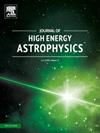Analysis of Hawking evaporation, shadows, and thermodynamic geometry of black holes within the Einstein SU(N) non-linear sigma model
IF 10.2
4区 物理与天体物理
Q1 ASTRONOMY & ASTROPHYSICS
引用次数: 0
Abstract
We explore the intriguing properties of black holes in the Einstein SU(N) non-linear sigma model with a focus on stability, thermodynamic geometry, the Hawking evaporation process, and shadow characteristics. Our study utilizes a novel generalized entropy framework which unify several established entropy models including Bekenstein, Barrow, Tsallis-Cirto, and Tsallis-Zamora entropies. By deriving expressions for specific heat capacity and Gibbs free energy, we unveil distinct stability regions and phase transitions. A key highlight of our investigation is the interplay between the flavor number and AdS length, which we show to profoundly influence black hole evaporation time via the Stefan-Boltzmann law. Numerical simulations reveal that higher flavor numbers shorten evaporation times and reduce the black hole's shadow radius, shedding light on the impact of SU(N) symmetry. Additionally, we employ Weinhold, Ruppeiner, and Quevedo thermodynamic geometries to compute scalar curvatures, visualizing microscopic interactions among black hole molecules. This comprehensive analysis bridges thermodynamic stability, quantum evaporation, and optical signatures, offering fresh perspectives on the rich dynamics of black holes in the Einstein SU(N) non-linear sigma model.
求助全文
约1分钟内获得全文
求助全文
来源期刊

Journal of High Energy Astrophysics
Earth and Planetary Sciences-Space and Planetary Science
CiteScore
9.70
自引率
5.30%
发文量
38
审稿时长
65 days
期刊介绍:
The journal welcomes manuscripts on theoretical models, simulations, and observations of highly energetic astrophysical objects both in our Galaxy and beyond. Among those, black holes at all scales, neutron stars, pulsars and their nebula, binaries, novae and supernovae, their remnants, active galaxies, and clusters are just a few examples. The journal will consider research across the whole electromagnetic spectrum, as well as research using various messengers, such as gravitational waves or neutrinos. Effects of high-energy phenomena on cosmology and star-formation, results from dedicated surveys expanding the knowledge of extreme environments, and astrophysical implications of dark matter are also welcomed topics.
 求助内容:
求助内容: 应助结果提醒方式:
应助结果提醒方式:


